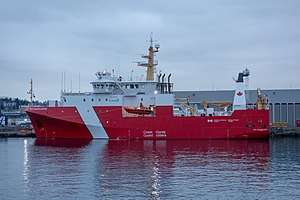CCGS Capt. Jacques Cartier
CCGS Capt. Jacques Cartier[note 1] is an offshore fisheries research ship of the Canadian Coast Guard. The ship was ordered in 2011 as part of the Canadian National Shipbuilding Procurement Strategy (NSPS) as a replacement for aging Canadian Coast Guard vessels. Capt. Jacques Cartier is the sister ship of CCGS Sir John Franklin and CCGS John Cabot. The ship was constructed at Seaspan Shipyard, Vancouver, British Columbia and launched on 5 June 2019.
 CCGS Capt. Jacques Cartier docked at Ogden Point in Victoria, British Columbia | |
| History | |
|---|---|
| Name: | Capt. Jacques Cartier |
| Namesake: | Jacques Cartier |
| Port of registry: | Ottawa, Canada |
| Ordered: | 19 October 2011 |
| Builder: | Seaspan Shipyard, Vancouver, British Columbia |
| Launched: | 5 June 2019 |
| Identification: |
|
| Status: | In service |
| General characteristics | |
| Type: | Fisheries research vessel |
| Displacement: | 3,212 t (3,161 long tons; 3,541 short tons) |
| Length: | 63.4 m (208.0 ft) |
| Speed: | 13 knots (24 km/h; 15 mph) |
Design and description
Capt. Jacques Cartier is the second of three vessels ordered on 19 October 2011 by the Canadian government under the NSPS for offshore fisheries research.[1] The three vessels are intended to replace the aging CCGS Teleost, CCGS W.E. Ricker and CCGS Alfred Needler.[2] The initial design for the research vessels called for a 55-metre (180 ft)-long ship that could act as "floating laboratories for scientific research and ecosystem-based management."[2][3] However, when Seaspan received the technical plans from the government in 2012, they found that the ship's design would be prone to capsizing. The design was altered, leading to an increased design length of 63.4 m (208 ft) and a larger displacement of 3,212 metric tons (3,161 long tons; 3,541 short tons), 610 metric tons (600 long tons; 670 short tons) more than initially planned.[3][4] The ships were constructed in 37 blocks and welded together.[1] The research vessels are powered by a diesel-electric system giving the ships a maximum speed of 13 knots (24 km/h; 15 mph). The ships are equipped with four labs; a wet lab, a dry lab, an ocean lab and a control lab.[5]
Service history
The research vessel was constructed at Seaspan Shipyard, Vancouver, British Columbia and launched on 5 June 2019.[6] The sister ship of CCGS Sir John Franklin and CCGS John Cabot, Capt. Jacques Cartier was named for Jacques Cartier, the French explorer who was the first European to land on the shores of the St. Lawrence River.[5] After sea trials, Capt. Jacques Cartier will be assigned to the Canadian Coast Guard base at Dartmouth, Nova Scotia.[6] Sea trials began on 10 October 2019.[7] The vessel completed sea trials and was handed over to the Canadian Coast Guard on 11 December 2019. Capt. Jacques Cartier is home ported at Dartmouth, Nova Scotia.[8]
Notes
- CCGS stands for Canadian Coast Guard Ship
Citations
- Kieltyka, Matt (25 October 2016). "First federal ship taking shape at Seaspan Vancouver Shipyards". Toronto Metro News. Retrieved 9 December 2017.
- "Shipbuilding projects to equip the Royal Canadian Navy and the Canadian Coast Guard - Offshore Fisheries Science Vessels". Canadian Coast Guard. 22 November 2017. Retrieved 9 December 2017.
- Cudmore, James (4 December 2015). "Design of Coast Guard's fisheries ships led to fears of capsizing". CBC News. Retrieved 9 December 2017.
- "Canada's Next Generation of Non-Combat Vessels". Seaspan Shipyards. Retrieved 9 December 2017.
- "Minister Wilkinson joins Seaspan to celebrate the launch of the Canadian Coast Guard's second new Offshore Fisheries Science Vessel" (Press release). Government of Canada. 5 June 2019. Retrieved 9 June 2019.
- Titus, Murray (5 June 2019). "Newest Coast Guard vessel launched in North Vancouver". CTV News. Retrieved 9 June 2019.
- Duffy, Andrew (10 October 2019). "Seaspan begins sea trials for second coast guard vessel, Jacques Cartier". Times Colonist. Retrieved 1 November 2019.
- "Capt. Jacques Cartier vessel sets sail east for coast guard". Times Colonist. 11 December 2019. Retrieved 12 December 2019.